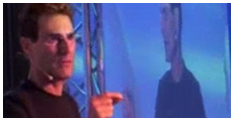Chapter 12
Fractures and cleavages
When a strip of metal is pulled sufficiently hard or bent by normal force to and fro a sufficient number of times, fracture will occur. If the metal is brittle, a single sufficiently strong normal moment or shear force will cause fracture. The fractured surface is then of characteristic appearance, with cup-shaped depressions and conical protuberances (cup-and-cone fracture). Most metals which have been exposed to metal-benders are ductile, and would normally require working to and fro before plastic fracture occurred. The appearance of the fractured surface is then rather different; there can be fatigue bars, necking, cavitation and slip lines. Necking also appears on fractures that have been produced by pulling alone, but this requires forces much greater than the moments or shear forces described above.
Many supposedly paranormal metal-bendings have terminated in fracture. The paranormal fractures I have observed took place without any working to and fro, either before the action or during it. Chapter 1 contains the description of an event which I observed closely: the softening and ultimate falling apart of a stainless steel teaspoon, brought about by Uri Geller. I was quite certain that the spoon was never worked to and fro manually by Geller. The metal became so soft that when I received it from his hands it was difficult for me to hold it sufficiently carefully for it to keep its shape. I felt that the metal was indeed soft, and although I placed it delicately on the desk to keep it in one piece, it eventually fell apart under its own weight.
It appears that a sufficiently strong paranormal action can bring about a reduction in the yield strength of the metal. Metal-bender Alison Lloyd described this sort of event, which she personally experienced several times, as ‘being able to pick holes in the metal with her fingernails’. One might interpret such a description in the following terms: tensile deformation without work-hardening is unstable; if some paranormal suppression of the work-hardening were to be postulated, then the metal would respond to a relatively small physical force with a ductile fracture.
But the appearance of paranormal ductile fractures under the scanning electron microscope is not very different from that of normal ductile fractures. Some early investigations were supervised by Dr Paul Barnes in our college.(27) A large number of electron micrographs were taken of a brass latchkey paranormally fractured by Uri Geller. Two detailed reports were written, one by each of the investigators. Although some unusual features emerged, it was not possible to isolate with certainty any properties of the paranormal fracture which would serve either as validation or as clues to the nature of the phenomenon. Similar findings have been reported by investigators in several countries, but evidence of highly locaised melting has recently been reported by Professor Sasaki in Tokyo. Comparison of electron micrographs of paranormally fractured pure platinum wires with similar manually fractured specimens has shown up very clear differences; locaised melting appears as rounded humps very clearly on the original micrographs.
A simpler type of break is the cleavage that occurs when a single crystal of metal is sheared. The fracture surface then follows one of the crystal planes, and can appear to be planar over quite large areas. Paranormal fractures of silicon and similar crystals have been reported in experiments with Uri Geller and Jean-Pierre Girard, and I have myself observed cleavages of single crystals of zinc by Graham P. and Andrew G., and of silicon crystals by Stephen North. The zinc crystals were 1-in.-long rods, about the thickness of a pencil, and Metals Research Ltd had prepared them with their 0001 surface perpendicular to the axis of the rod.
Each of the following types of paranormal crystal cleavage has been brought about by the observed stroking action of metal-benders:
1 The crystal cleaved straight across, leaving mirror-like 0001 cleavage surfaces on each piece. One piece remained between the thumb and forefinger, and the other simply dropped off the end, at some distance from the hand.
2 An 0001 cleavage crack developed part of the way across the length of the crystal, within a few millimetres of the end, but, again, beyond the end of the thumb and forefinger.
3 A flake of 0.1 mm thickness hinged upwards at an angle of about 45° from the end of the crystal and remained in position, although it was very delicate.
4 A slight kink developed in the crystal, but without cracking.
5 Grains of about 1 mm in size parted from the crystal, leaving the edges badly scarred. An 0001 plane crack also appeared.
It is true that even at room temperature these zinc crystals will deform and cleave fairly easily. Three-point loading of a 7 cm length with 4 kg causes some yield, followed by a cleavage. A blow with a sharp blade mounted on a weight of 500 gm dropped from a height of 15 cm also causes cleavage. Nevertheless the handling of the crystals by the children was observed by me and seen to be much more gentle than this; I hesitate to fault my own handling, or that of Metals Research.
In paranormal cleavages the surface of action presumably remains planar over a macroscopic region, and acts only in a certain crystal plane, in this case 0001. But a crack will propagate along a plane, even though the force is locaised at the edge of the crystal, so that it is not clear just how far the planar surface of action extends. In the fracture of aluminium strips bonded by epoxy-resin, as described in chapter 3, the action is also planar at the metal-epoxy interface; one of the metal strips might be imagined to experience dynamic strain and the other not. These bonds are very much stronger than in the zinc crystals.
The paranormal cleavage of inorganic single crystals has been investigated by Rauscher and Hubbard.(28) Uri Geller brought about one such event, and later Elizabeth Rauscher and I observed Stephen North bring about, without touch, the cleavage of a single crystal with strain gauges attached. Electron micrographs showed up cavitation of the inorganic crystal surface. This will be discussed further in the next chapter.


Latest Articles

Motivational Inspirational Speaker
Motivational, inspirational, empowering compelling 'infotainment' which leaves the audience amazed, mesmerized, motivated, enthusiastic, revitalised and with a much improved positive mental attitude, state of mind & self-belief.


















